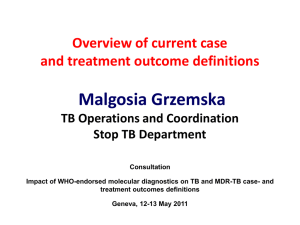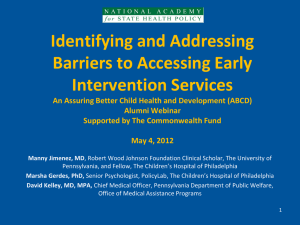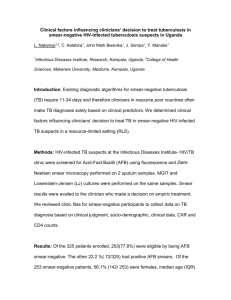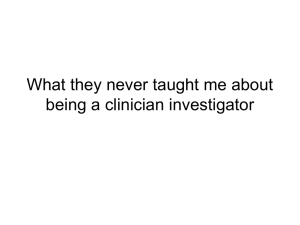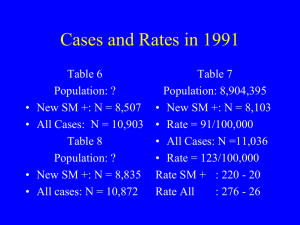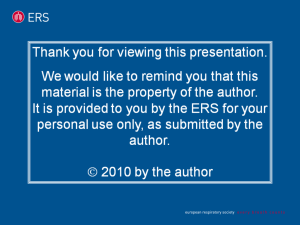Delayed TB Diagnosis
advertisement
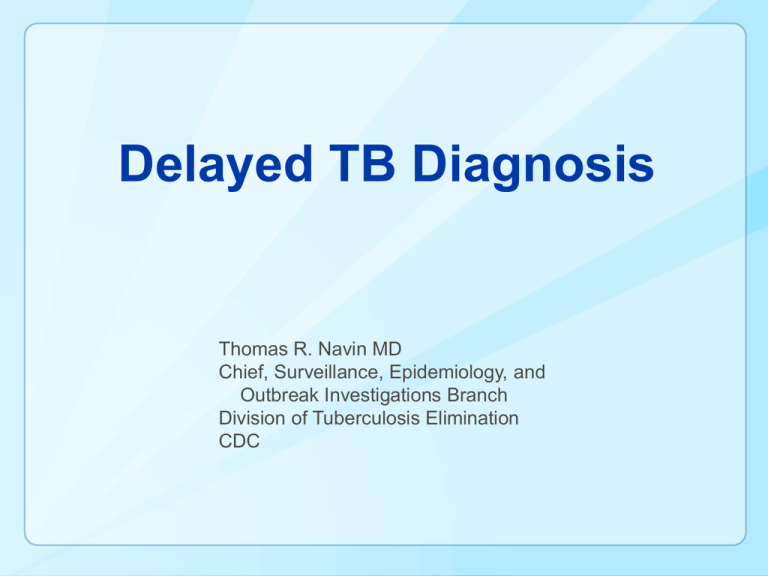
Delayed TB Diagnosis Thomas R. Navin MD Chief, Surveillance, Epidemiology, and Outbreak Investigations Branch Division of Tuberculosis Elimination CDC Test of Baseline Knowledge How many patients are evaluated for TB each year in the United States? Are the number of persons evaluated going down or staying stable? Are delays in TB diagnosis getting worse? Are delays worse for racial/ethnic minorities? Patients Evaluated for TB at CDC-funded Public Health Laboratories, 2008-2009 2008 Patients evaluated for TB 2009 % change 103,708 97,568 -5.9% Patients with cultures positive for M. tuberculosis 4,972 4,217 -15.2% Ratio of patients evaluated to patients diagnosed with TB 21 : 1 23 : 1 Measuring TB Diagnostic Delay Preliminary Results from TBESC Task Order 23: National Study of Early Diagnosis of TB in the African-American Community Co-Principal Investigators: Dolly Katz, Ph.D., CDC Rachel Royce, Ph.D., M.P.H., RTI International Charles Wallace, Ph.D., Texas Department of Health 4 Months from Symptom Onset to Diagnosis (N=346) Race African-American White p=0.04 5 Mean (SD) Median 4.4 19.7 (6.1) (48.4) 2 4 Months from Symptom Onset to First Medical Care: Patient Delay (N=346) Race African-American White p=0.8 6 Mean (SD) Median 2.4 9.2 (5.2) (29.5) 1 1 Months from First Medical Care to Diagnosis: Provider Delay (N=346) Race African-American White p=0.4 7 Mean (SD) Median 2.2 4.5 (3.5) (4.5) 1 1 Summary of Findings from Task Order 23: Study of Patient and Provider Delay Snap shot in time (rather than trend over time) Both patient and provider delay observed Delay not worse for African Americans compared with whites Contribution of Provider Diagnostic Delay to 27 TB Outbreaks Investigated by CDC* Contributing factors Number of Outbreaks where item was considered a contributing factor Prolonged infectious period Provider-related diagnostic delay Patient-related delay in access to care * From: Mitruka et al., EID 2011;17(3):425 24 12 6 National TB Surveillance System: Trends in culture-positive, smear-negative pulmonary TB Data from Recent TB Outbreak Cases by sputum smear status 6 5 TB Cases 4 Smear-negative Smear-positive 3 2 1 0 Mar Apr May Jun Jul Aug Sep Oct Treatment Start Date Culture-confirmed Pulmonary TB by Sputum Smear Status, United States 2000-2009 5000 TB Cases 4000 3000 Smear positive Smear negative 2000 Smear status unknown/not done 1000 0 2000 2001 2002 2003 2004 2005 2006 2007 2008 2009 2010 Proportion of Pulmonary TB Cases* That Are Sputum Smear-Negative, United States, 2000-2009 100% 80% 60% 40% 20% 0% 2000 2001 2002 2003 2004 2005 2006 2007 2008 2009 •Culture-positive TB cases Proportion of Pulmonary TB Cases* That Are Sputum Smear-Negative, by Race/Ethnicity United States, 2000-2009 100% 80% 60% White Black Hispanic 40% 20% 0% 2000 2001 2002 2003 2004 2005 2006 2007 2008 2009 TB Case Count Date * Culture-positive TB cases Test of What You Have Learned How many patients are evaluated for TB each year in the United States? Are the number of persons evaluated going down or staying stable? Are delays in TB diagnosis getting worse? Are delays worse for racial/ethnic minorities? Test of What You Have Learned How many patients are evaluated for TB each year in the United States? 100,000 persons evaluated each year at public health labs alone Ratio of evaluated-to-diagnosed: 20+ Are the number of persons evaluated going down or staying stable? Number is going down, but ratio of evaluated-to-diagnosed may be going up Test of What You Have Learned Are delays in TB diagnosis getting worse? Data are not good, but no evidence of worsening Are delays worse for racial/ethnic minorities? Data are not good, but no evidence of a difference Getting Physicians to “Think TB” is asking them to look for a needle in a haystack Lung CA TB (0.3%) Community-acquired pneumonia Can Physicians be Educated to “Think TB”? • As TB rates decline, general medical expertise and education targeted at TB will decline • Untargeted campaigns may not be successful • “Think TB” campaigns may have impact in targeted situations: • In high-risk communities • During outbreaks Can Physicians be Educated to “Think TB”? Challenges During TB Outbreaks • Most media stories about TB “outbreaks” describe contact investigations at schools • Most contact investigations at schools do not detect additional TB cases • Health Departments often work hard to keep information on large TB outbreaks out of media Outbreak-associated TB cases can make up a significant portion of TB cases in a community and can continue for years Outbreak Associated TB Cases, 2002-2010 (N=109) 25 15 10 5 a As of August 2010 20 10 * 20 09 20 08 20 07 20 06 20 05 20 04 20 03 0 20 02 No. of cases 20

